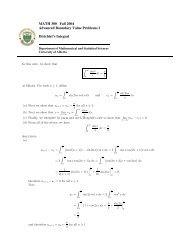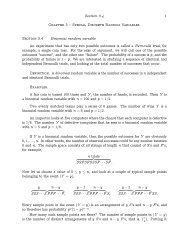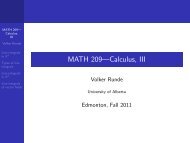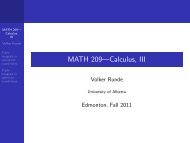Math 527 A1 Homework 5 (Due Nov. 26 in Class) Proof. i. Set u = v(x ...
Math 527 A1 Homework 5 (Due Nov. 26 in Class) Proof. i. Set u = v(x ...
Math 527 A1 Homework 5 (Due Nov. 26 in Class) Proof. i. Set u = v(x ...
You also want an ePaper? Increase the reach of your titles
YUMPU automatically turns print PDFs into web optimized ePapers that Google loves.
As F is strictly convex, the behavior of the denom<strong>in</strong>ator close to ul and ur is like (z − z0) −1 . And<br />
thus if v(s)=ul or ur, necessarily s = ∓ ∞.<br />
F<strong>in</strong>ally, fix any s 0 f<strong>in</strong>ite, we have<br />
s<br />
ε =<br />
�<br />
c<br />
v(s)<br />
1<br />
dz. (12)<br />
F(z) − σ z + b<br />
When ε ց 0, the LHS → ∓ ∞, consequently v(s) → ul or ur. Thus we see that as ε ց 0, v ε converges<br />
to v at every s 0. �<br />
Exercise 2. (5 pts) (5.10.3) Denote by U the open square � x ∈ R2N|x1| < 1, |x2| < 1 � . Def<strong>in</strong>e<br />
⎧<br />
⎪⎨<br />
1 − x1 x1 > 0, |x2| < x1<br />
1 + x1 x1 < 0, |x2| < − x1<br />
u(x) =<br />
. (13)<br />
1 − x2 x2 > 0, |x1| < x2<br />
⎪⎩ 1 + x2 x2 < 0, |x1| < − x2<br />
For which 1 �p �∞ does u belong to W 1,p (U)?<br />
Solution. First we can easily check that u ∈ C � Ū � and is smooth <strong>in</strong>side each triangle. If we def<strong>in</strong>e v<br />
piecewisely such that v = Du <strong>in</strong> each triangle, it is clear that v ∈W 1,p for any p. Now what is left to show<br />
is that v = Du <strong>in</strong> U.<br />
1 Take any φ ∈C0(U). Denote by Ui, i=1, , 4, the triangles. We have<br />
�<br />
v φ=<br />
U<br />
�<br />
�<br />
Duφ=−<br />
Ui i<br />
�<br />
�<br />
u Dφ+<br />
i<br />
�<br />
�<br />
niuφ. (14)<br />
∂Ui i<br />
As u is cont<strong>in</strong>uous across any common boundary of any two Ui’s, and φ = 0 on ∂U, the boundary terms<br />
sum up to 0.<br />
�<br />
Exercise 3. (10 pts) (5.10.14) Verify that if n > 1, the unbounded function u = loglog 1 + 1<br />
�<br />
belongs to W<br />
|x|<br />
1,n (U),<br />
for U = B0 (0,1).<br />
<strong>Proof</strong>. Compute<br />
Thus we have<br />
Now we have<br />
�<br />
<strong>Set</strong>t<strong>in</strong>g z = log<br />
�<br />
B(0,1)<br />
1+ 1<br />
�<br />
, we have<br />
r<br />
�<br />
Du =<br />
B(0,1)<br />
1<br />
�<br />
log 1 + 1<br />
|x|<br />
|Du| � C<br />
�<br />
1<br />
1 + 1<br />
�<br />
−<br />
|x|<br />
x<br />
|x| 3<br />
�<br />
1<br />
�<br />
log 1+ 1<br />
|x|<br />
|Du| n � 1<br />
dx � C<br />
0<br />
�<br />
log<br />
(15)<br />
� 1<br />
. (16)<br />
|x|<br />
1<br />
1+ 1<br />
r<br />
� n<br />
1<br />
dr (17)<br />
r<br />
|Du| n � ∞<br />
1<br />
dx�C dz < + ∞ (18)<br />
log2 zn when n >1. �







